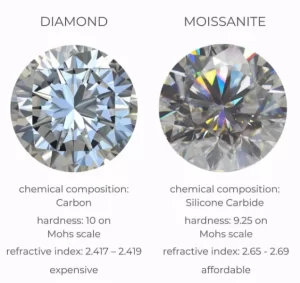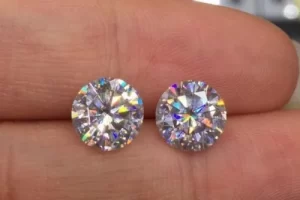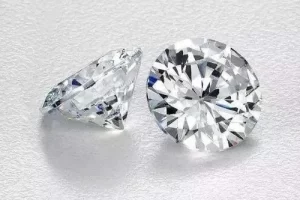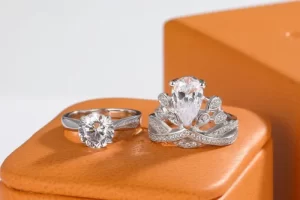A rainbow of dazzling gems exists beyond traditional diamonds – welcome to the world of diamond alternatives. Two popular scientifically-created options, moissanite, and lab-grown diamonds, compete for jewelry glory.
These sparkling stones boast optical brilliance exceeding natural limitations thanks to human ingenuity. Both deliver Socially conscious shine too as eco-friendly, conflict-free choices.
But questions come up over which laboratory gem works best. As man-made marvels, what exactly differentiates moissanite from cultured diamonds? And how to pick the perfect one for your needs?
Comparing the science, aesthetics, ethics, and economics behind these gems helps uncover your best-fit sparkler.

The Carbon Copy Challenge
At a glance, discerning moissanite from lab diamonds proves tricky. Science skillfully replicated the diamond’s alluring illusion in both. Let’s investigate what sets them apart.
Made of:
Moissanite – Silicon carbide
Lab Diamonds – Pure carbon
Hardness on Mohs Scale:
Moissanite – 9.25
Lab Diamonds – 10
Refractive Index:
Moissanite – 2.65-2.69
Lab Diamonds – 2.42
Dispersion/Fire:
Moissanite – Very high
Lab Diamonds – High
Facets & Cuts:
Moissanite – Custom cuts
Lab Diamonds – Classic diamond
Cost for 1 Carat:
Moissanite – $300-500
Lab Diamonds – $800-2000
Now that we see the technical differences between moissanite versus cultured diamonds, how do they compare aesthetically and ethically?

To Sparkle or To Shine: A Matter of Optical Style
Beauty resides in the eye of the beholder, but optical science also plays a role. Based on physics, moissanite and lab diamonds dance with light differently to produce their beauty. Here is how:
Refractive Rainbows
A gem’s refractive index measures how drastically it bends incoming light beams. The higher this number, the sparklier the show! With extra light bending magic, moissanite supplies more visible luminescence and fire.
Dispersion Devotion
Dispersion quantifies the breadth of rainbow colors splashing around inside. While moissanite takes the color spectrum cake too, lab diamonds still tally plenty of flash.
Brilliant Cuts
Well-angled facets help rays reflect and refract optimally to exit dazzling the viewer. Moissanite unlocks more customized cuts thanks to malleable manufacturing. But even in trademark radiant or princess cuts, lab diamond optics shine.
So while moissanite objectively tosses more measurable light refraction, both stones stun with beauty behaving subjectively to the eye. Moissanite’s crisper optics tend to suit bling lovers while lab diamond’s subtler shine wows those wanting diamond mimicry.

Ethics of Synthetic Stones
Beyond beauty stats lies responsible sourcing. The dangers of diamond mining for human rights and ecology contrast with the controlled production of man-made sparklers. Both scientifically-grown gems rate highly ethical with considerations around:
- Working Conditions– Safely regulated
Environment – Low-impact energy usage
Social Equity – Opportunity for underserved groups when profit gets reinvested
However, while lab diamond tech still supports conventional diamond industry conglomerates, moissanite uniquely disrupts the status quo as an outsider upstart.
So who wins the ethics crown? Lab diamond methods hold the promise of lowering supply/demand pressures on mining. But Moissanite’s clean origin storyline simply sparkles.
Cost Comparison
Budget plays a pragmatic role when evaluating any big purchase. Let’s see how moissanite and lab diamond prices size up.
For an equivalent carat dazzler, moissanite rings cost 10-30% of a natural diamond. Competitively, lab diamonds retail for 40-50% less thanks to efficient manufacturing. However, both synthetic options save substantial financial resources over their mined counterparts.
Value also gets measured in long-term retention. If reselling, lab diamonds hold steadier appraisals than their earthen cousins. But Moissanite’s appeal stays strong with its unparalleled optical moxie.
Ultimately moissanite prevails as the wallet-friendlier choice. Lab diamond prestige appeals to those prioritizing investment and tradition. But optically superb moissanite steals affordability shine.

Finding Your Forever Stone Match
When choosing between scientifically sourced stones, from ethics to economics, optics to originality, one gem tends to crystalize as the leader of light. But in matters of personal preference, your perfect gem depends on what captivates your heart.
If prioritizing diamond nostalgia and value retention, excellent lab diamonds mimic the real deal sparkling beautifully. But if seeking a socially-conscious showstopper unmatched by nature, moissanite’s dazzling light assassinates affordably. There’s your perfect, forever shine either way!
So which calls to you – timeless traditions or a brazen new frontier? Let your unique taste, style and aspirations guide you to the resplendent stone reflecting your values for a lifetime and beyond!

FAQs
1. What is the main difference between moissanite and lab-grown diamonds?
The main difference is their chemical composition. Moissanite is made from silicon carbide while lab-grown diamonds are pure crystallized carbon, just like mined diamonds. This affects certain qualities like hardness, refractive index, dispersion of light, and appearance.
2. Which stone is more eco-friendly, moissanite or lab diamonds?
Both moissanite and lab diamonds have eco-friendly production methods compared to mined gems. However, moissanite is considered more ethical and sustainable since its manufacturing has less environmental impact and doesn’t rely on or fund the conventional diamond industry.
3. Is moissanite as durable as a lab diamond for wearing every day?
Very nearly. On the hardness scale, moissanite rates slightly lower at 9.25 compared to a diamond’s 10 rating, lab-grown or not. But moissanite remains extremely durable for jewelry worn daily. Both stones suit everyday wear excellently.
4. Which stone has more sparkle and brilliance, moissanite or lab diamond?
Moissanite technically exhibits more sparkle and brilliance. Its higher refractive rating of 2.65-2.69 versus a diamond’s 2.42 causes more light return and rainbow fire flashing inside the stone. This extra visual dazzle suits those wanting maximum shine.
5. Is moissanite cheaper than a lab-grown diamond?
Yes, moissanite runs significantly cheaper than lab diamonds (and mined diamonds). Price varies for each based on cut, carat, color, and clarity grade, but on average moissanite costs about 10-30% of a comparable quality lab diamond’s retail pricing. This makes Moissanite the budget saver.

